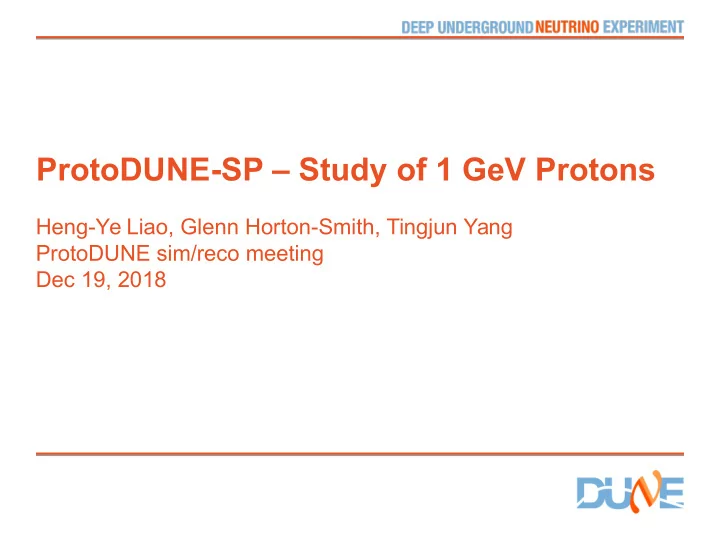

ProtoDUNE-SP – Study of 1 GeV Protons Heng-Ye Liao, Glenn Horton-Smith, Tingjun Yang ProtoDUNE sim/reco meeting Dec 19, 2018 You Inst Logo You Inst Logo
Outline • Motivation • Data sample • Analysis procedure • Event display • Summaty & Outlook 2 Presenter Name | Presentation Title You Inst Logo You Inst Logo
Motivation • Detector response for protons (i.e., Proton dE/dX) → Tag stopping protons firstly for the study 3 Presenter Name | Presentation Title You Inst Logo You Inst Logo
Data Sample • Use recommended run from Owen → See Owen’s good run list in: https://indico.fnal.gov/event/19262/contribution/14/materi al/slides/0.pdf • Run number: 5387 • Use entire run for this analysis • Run info: - High voltage: 180 kV - Beam momentum: 1 GeV/c - Purity: > 5ms 4 Presenter Name | Presentation Title You Inst Logo You Inst Logo
Filter & Sanity Check • Use Justin Hugo’s filter to select 1GeV beam protons (see Justin’s slides for more details: https://indico.fnal.gov/event/19185/contribution/2/material/slid es/0.pdf) • Use Jack Calcutt’s LArSoft module to get beam info (https://wiki.dunescience.org/wiki/Look_at_ProtoDUNE_SP_d ata#Parsing_Beamline_Information) 5 Presenter Name | Presentation Title You Inst Logo You Inst Logo
Beam Position Beam Inst. Primary Track [cm] [cm] Z 0 32.73 Position (0) (0.939) Y 421.01 423.38 Position (3.876) (4.753) X -29.75 -19.43 Position (4.118) (4.358) Values in the table: Mean (Sigma) You Inst Logo You Inst Logo 6
Track Selection – Angle Cut Beam direction P r i m a d r i y r e t r c a t i c o k n Cut at 0.93 You Inst Logo You Inst Logo 7
Track Selection – Position Cut Before angle cut After angle cut 27 < ∆Z < 39 [cm] 0 < ∆Y < 10 [cm] 6 < ∆X < 15 [cm] You Inst Logo You Inst Logo 8
Track Length Distribution You Inst Logo You Inst Logo 9
Track Length Distribution You Inst Logo You Inst Logo 10
Proton Length 92.58 cm • Convert proton momentum to its CSDA range - CSDA range: Average path length traveled by a charged particle as it slows down to rest (continuous-slowing-down approximation) - NIST data base of proton travels in argon (https://physics.nist.gov/PhysRefData/Star/Text/PSTAR.html) - Use Friedman’s super smoother to get the associtated function (Friedman, J. H. (1984) SMART User's Guide. Laboratory for Computational Statistics, Stanford University Technical Report No. 1.) You Inst Logo You Inst Logo 11
Track Length Distribution Peak position=0.84 “Interacting” Protons Stopping Protons You Inst Logo You Inst Logo 12
Monte Carlo simulation • Use MCC11 1GeV/c proton sample (full data set) to do the same analysis You Inst Logo You Inst Logo 13
Track Length Distribution (MC) Peak position=0.94 Without space charge effect You Inst Logo You Inst Logo 14
Track Length Distribution (MC) You Inst Logo You Inst Logo 15
Event Display 79.3 cm You Inst Logo You Inst Logo 16
Event Display 36.7 cm You Inst Logo You Inst Logo 17
Event Display 3.57 cm You Inst Logo You Inst Logo 18
Event Display 1.58 cm Broken track? You Inst Logo You Inst Logo 19
Event Display 3.05 cm You Inst Logo You Inst Logo 20
Summary & Outlook • Developed methods to tag stopping protons • Next Step: - Track length distribution with space charge effect / fluid flow - Work on PFparticle product and its application You Inst Logo You Inst Logo 21
Recommend
More recommend